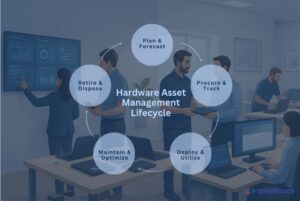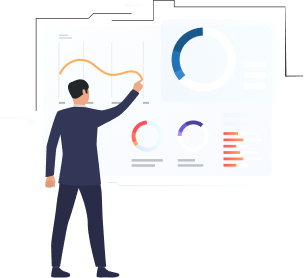Introduction
Did you know up to 30% of IT hardware assets go unaccounted for without proper tracking? Regulators are raising the stakes too – for example, new SEC cybersecurity rules require companies to account for every IT asset from acquisition through disposal. These pressures make managing the full hardware asset management lifecycle more critical than ever.
>>Dive into strategic best practices and expert guidance—learn about hardware asset management
In this post, we’ll break down the entire IT hardware lifecycle – from planning and procurement to deployment, maintenance, and retirement – and share best practices to manage each stage effectively. You’ll learn how to optimize your hardware asset management lifecycle (especially for endpoint devices like laptops) to reduce waste, stay compliant, and maximize ROI. Along the way, we’ll show how a platform like AssetCues can help improve visibility, compliance, and cost control at every phase.

Planning (Stage 1 – Plan and Forecast)
Planning is the first stage of the hardware asset management lifecycle, where IT teams identify hardware needs and strategize how to meet them. A solid plan aligns hardware investments with business strategy and sets the foundation for the later stages. Key planning practices include:
-
Access Current Assets & Needs:
Audit your current hardware inventory and evaluate its condition. Forecast upcoming needs based on business growth, user roles, and technology refresh cycles. Consider using an IT asset management system (e.g., AssetCues) for a real-time view of existing assets.
-
Budget and Lifecycle Policy:
Set a budget and define clear hardware refresh policies. Standardize refresh cycles (e.g., replace laptops every 3–4 years) to avoid overspending and surprise costs.
-
Set Standards and Compliance Goals:
Standardize approved hardware models and configurations to simplify support. Ensure new purchases meet security and compliance requirements, and address any licensing or regulatory needs upfront.
-
Leverage Data for Forecasting:
Use data to predict future hardware demand. Review factors like warranty expirations, performance metrics, and projected headcount to anticipate replacements or new purchases.
Procurement (Stage 2 – Acquire and Track Assets)
Procurement is the stage of acquiring hardware according to the plan. It involves selecting and purchasing (or leasing) equipment and ensuring each item is properly recorded in your inventory. To optimize procurement in hardware asset lifecycle management:
-
Vendor Selection & Standards:
Stick to the standard hardware models defined in your plan and buy from approved vendors. Standardizing devices (and buying in bulk) can yield discounts and simplify support.
-
Inventory Intake & Tagging:
Immediately log each new device in your inventory system. Tag hardware with asset IDs (barcodes or RFID) and record key details (model, serial number, purchase date, etc.). This process prevents “ghost assets” – devices that get purchased but never recorded.
-
Contract and Warranty Management:
Keep records of vendor contracts, SLAs, and warranty periods for each asset. Set alerts for warranty expirations or support contract renewals so you can decide in time whether to extend coverage or plan a replacement.
-
Compliance Checks:
Verify each new device meets your security and compliance standards (for example, that it includes required encryption hardware and runs an approved OS). Also document any software licenses that come with the device to stay compliant.

Maximize ROI Across Your IT Assets
Get full visibility and control at every stage of the hardware lifecycle.
Maximize ROI Across Your IT Assets
Get full visibility and control at every stage of the hardware lifecycle.

Deployment (Stage 3 – Deploy and Utilize)
Deployment is the stage where acquired hardware is configured and delivered to end users (or into production). A smooth deployment allows employees to start using devices quickly and securely. Best practices in hardware asset lifecycle management include:
-
Standardized Imaging & Setup:
Prepare each device with a standard operating environment (OS image, required software, security settings, etc.) so it’s compliant and ready to use upon handoff.
-
Handover and Documentation:
When you issue hardware to an employee (or a department), document the assignment. Have users sign required use policies or handover forms, and record the “who, where, and when” of each asset in your system to maintain an audit trail.
-
Configuration and Integration:
Ensure devices are properly installed and integrated into your environment (e.g., keep servers in secure, well-cooled locations). Connect end-user devices to the network, enroll them in management systems, and verify they can access required resources
-
User Training & Support:
Provide basic training to employees when they receive new hardware. Informed users will take better care of devices and report issues promptly. Also ensure an IT support process is in place to handle any early problems after deployment.
Maintenance (Stage 4 – Maintain and Optimize)
Maintenance is the longest phase of the lifecycle, covering day-to-day operations once hardware is in use. This stage includes routine monitoring, repairs, and performance optimization. Key considerations in hardware asset lifecycle management include:
-
Asset Monitoring:
Continuously monitor hardware health and usage—no device should be “set and forget.” Use monitoring tools to track performance, software updates, and security status. Catching issues early (like a failing drive or out-of-date antivirus) can prevent downtime or security incidents.
-
Routine Maintenance & Updates:
Schedule regular maintenance tasks such as cleaning equipment, installing OS/firmware updates, applying security patches, and replacing consumables (like batteries) as needed. Keeping firmware and drivers up to date ensures optimal performance and security.
-
Repairs and Support:
Have a clear process for when hardware breaks. Keep a repair history for each asset (if a device has multiple major fixes, consider replacing it early). If equipment is under warranty or a support contract, work with the vendor for repairs to minimize costs.
-
Compliance & Audits:
Continuously enforce company policies and relevant regulations during the maintenance phase. Verify that each device has only authorized software, required security controls (encryption, antivirus) are active, and usage adheres to policy. Also conduct periodic physical asset audits to ensure your inventory records match reality.

Say Goodbye to Lost or Untracked Hardware
From durable asset tags to real-time tracking, AssetCues makes IT asset management effortless and accurate.

Say Goodbye to Lost or Untracked Hardware
From durable asset tags to real-time tracking, AssetCues makes IT asset management effortless and accurate.
Retirement (Stage 5 – Retire and Dispose)
Retirement is the final stage of the lifecycle, when hardware is safely removed from service at end-of-life. This phase involves deciding when to retire devices and how to dispose of them securely and in compliance. Key steps include in hardware asset lifecycle management:
-
When to Retire:
Establish clear criteria for when to retire or replace a device. Common triggers include when a device is too old to be efficient, when repair costs exceed replacement cost, when it stops receiving security updates, or when a lease expires.
-
Data Sanitization:
Before disposing of any hardware, securely wipe or destroy all data on it. This is crucial for user devices that held sensitive information. Use certified data-erasure tools or physically destroy drives (and document the process) to ensure no residual data can be recovered.
-
Disposition Options:
Decide whether to reuse an asset internally, sell or donate it, or recycle it as e-waste. Use certified IT asset disposition (ITAD) services or recyclers to handle disposals securely and comply with environmental laws. If you resell or donate equipment, ensure all data has been wiped. For a structured approach, refer to this asset disposal plan to guide responsible and compliant end-of-life decisions.
-
Record and Confirm:
Mark the asset as retired in your inventory system once it’s disposed of. Note how it was disposed (sold, recycled, donated, etc.), when, and by which vendor or method. Obtain proof of disposal or data destruction (e.g., a certificate from an ITAD provider). Also update your financial records to remove the asset from your books once disposed.
FAQs
Q. What is the hardware lifecycle management system?
A. A hardware lifecycle management system refers to the framework or tools used to oversee hardware assets from cradle to grave. It tracks each device’s journey – procurement, deployment, support/maintenance, and eventual retirement – and often automates tasks like inventory updates and performance monitoring throughout that lifespan.
Q. What is hardware lifecycle replacement?
A. Hardware lifecycle replacement is a planned approach to refresh equipment at the end of its useful life. It involves scheduling the acquisition of new hardware and the decommissioning of aging devices (like PCs, printers, etc.) on a regular cycle to maintain productivity and reduce failures.
Q. What are the stages of hardware asset management?
A. The hardware asset lifecycle includes five main phases starting with planning and forecasting needs. Moreover, companies handle procurement, deployment, maintenance operations, and final retirement of all equipment. Subsequently, organizations track each stage ensuring optimal usage and proper accountability throughout equipment lifespans.
Q. Why is hardware asset lifecycle management important?
A. Proper hardware asset lifecycle management saves companies significant money while reducing operational security risks. Additionally, organizations maintain better control preventing equipment losses and ensuring regulatory compliance requirements. Furthermore, businesses achieve maximum value from investments avoiding costly surprises and audit penalties.
Conclusion & Next Steps
Managing the hardware asset lifecycle isn’t just an IT chore – it’s a strategic practice that drives efficiency, security, and cost savings. By planning needs, tracking assets, proactively maintaining equipment, and retiring hardware responsibly, you ensure your organization gets the best value from every device while avoiding issues like lost assets or audit penalties.
Crucially, having the right tools makes hardware lifecycle management far easier. AssetCues provides a unified platform to monitor and optimize each stage of the lifecycle, giving IT teams full visibility and control over their assets. Instead of juggling spreadsheets or reacting to problems too late, you can stay ahead of the curve knowing exactly what you have and where it is.
About Author







